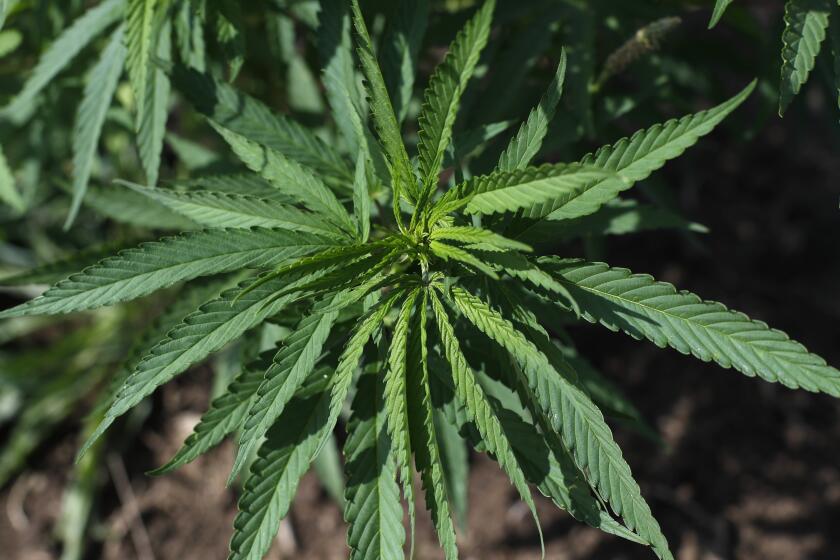A Growing Problem
As dusk descends in the San Gabriel Mountains, a white pickup pulls over to the side of the Angeles Crest Highway and a man clambers out, lugging a bag marked “K-Grow.” He plods into the brush, and radios crackle as federal agents hiding along the crest report his position.
Welcome to a little-known front line in the war on drugs: the Angeles National Forest, where a small squad of federal agents plays a dicey game of cat and mouse with marijuana farmers armed with high-powered rifles and cellular phones.
The recent arrest of members of a family which allegedly trafficked in millions of dollars of marijuana grown on federal land is a reminder of how growing pot has gone from an act of ‘60s rebellion to a deadly big business. Marijuana farmers in the national forest chase off hikers with rifles and slaughter wildlife in the pristine wilderness, inflicting environmental damage.
They also monopolize the time of the 14-member law enforcement team that patrols the million-acre forest during the 10-month growing season. Although marijuana-growing on federal lands is a problem nationally, with groves springing up from Idaho to Arkansas, it is arguably most serious in the Angeles forest--the most heavily used park in the nation.
“We have 14 law enforcement people to cover one-quarter of Los Angeles County,” said Forest Service special agent Mike Alt. “The other three-quarters of Los Angeles County is covered by 18,000 police officers.”
The strain on personnel will be in full evidence this month as marijuana harvesting season cranks into high gear. Although the “Emerald Triangle” of Northern California remains in the minds of many the prime place for pot growers, the vast majority of marijuana plants seized by the U.S. Forest Service last year came from Southern California’s spacious and rugged national forests.
The country’s national forests are a favorite place for pot growers to tend their crop, with more than 3 million plants--about $9.5 billion worth--seized since 1990 nationwide. By growing illegal drugs on public lands, farmers avoid having their own property seized under federal civil forfeiture laws.
As growing pot becomes more profitable, it becomes more dangerous to both visitors to the forest and the environment of the wilderness areas. The farms--which can be as small as a few dozen plants or as vast as thousands of plants running up and down canyon walls--often sit within a mile of heavily used trails, and are sometimes discovered by hikers.
*
One woman who unknowingly hiked into a plantation in the Angeles forest tripped a booby-trap which fired a shotgun shell an inch over her head. A pair of deer hunters were chased out of a 10,000-plant farm in the Los Padres Forest by two growers with AK-47s, Forest Service agents say.
Land surveyors stumbled onto another garden in the Angeles forest. When they realized what they had found they scrambled away--but were true to their profession and left yellow flags marking the garden for the Forest Service. Fortunately, the surveyors were not spotted, agents say.
It’s not just humans who are threatened by the farms. Farmers use fertilizers to strengthen the plants, but the fertilizers can kill surrounding vegetation. Farmers dump their waste in creek beds, sometimes building artificial dams and disrupting the stream’s natural flow. In a plantation raided last month behind Big Santa Anita Canyon, five acres of ancient trees were clear-cut to make way for the pot.
Rats and rabbits eat marijuana voraciously, so farmers scatter rat poison around the plantations. At one garden, agents found seven dead deer--and the pelt of a bear.
“People say, ‘What’s the big deal? Marijuana’s a natural crop,’ ” Alt said. “But, you know, 96% of all users of hard drugs started with marijuana.”
There’s good reason marijuana has long held a place as the nation’s top cash crop. A hardy weed that is so toxic to insects that it was used as a natural pesticide in 19th century farms, it can survive in most environments and needs only minimal water.
“It’s a weed,” says Peter Gorman, executive editor of High Times, which covers the marijuana industry. “It’s not going away.”
But to become a “quality” drug, marijuana requires a fair amount of care, experts say. Male and female plants must be separated, the crop must be at least lightly watered and gardeners must keep an eye out for wild animals who like to dine on it.
That makes growing pot in the dry environs of the Angeles National Forest--and in neighboring San Bernardino and Cleveland national forests--a complicated matter. Farmers have been known to tote buckets of water from creeks to their isolated plantations, but more commonly they rig up sometimes startlingly complex irrigation systems for their crop.
Industrious farmers--or “dopers,” as the Forest Service has dubbed them--will bury pipes up to eight inches underground to drain far-off streams. Some even tap into cisterns kept in the forest for firefighting.
The people who water, tend and harvest the plants usually carry guns and are often hired straight off the street by the owner of the plants, then shipped into the forest for months at a time, federal officials say.
Such was the case with Hugo Enrique Galarza-Rueda.
Galarza-Rueda, 23, was living in Pasadena when a man identifying himself only as “El Cholo” approached him and offered him a job tending his 1,880 plants in a grove nestled in Devil’s Canyon in the San Bernardino National Forest, according to court documents.
*
Galarza-Rueda and another man spent four months in the forest tending the crop. On Mondays and Tuesdays a man came and brought them supplies. When federal agents raided their camp in August 1995 they found two small tents, a cooking stove, eggs, peppers and onions among the plants--plus a semiautomatic pistol.
As the agents led him out of the camp, Galarza-Rueda asked if he could bring his Bible. Months later, he pleaded guilty to drug charges that earned him a 10-year mandatory federal prison sentence.
Agents have some sympathy for the drug trafficking version of day laborers, who are almost always the only people arrested in the pot raids, only to be abandoned by their employers.
“These people are merciless,” Wear said. “They don’t care what happens to the people they hire.”
But for perhaps the first time, the Forest Service last week collared one of the alleged masterminds. In a series of dawn raids, agents arrested Indelicia Cardenas, her husband, Luis, and three other members of the Cardenas family, as well as three other people who allegedly helped grow and distribute millions of dollars of marijuana throughout California and Mexico.
The Cardenases had been tied to at least five plantations in the Angeles before last week’s raid, and Los Angeles County sheriff’s detectives and federal agencies were gathering information on them for five years. They found marijuana plants even in the backyard of the Cardenas home in Highland Park, investigators said.
But when the Forest Service raided the Cardenas family on a week ago, visitors to the national forest may have noted a curious phenomenon: There were no rangers on patrol in the park’s nearly 700,000 acres. The massive raids took the entire 14-person law enforcement team, in addition to agents borrowed from Northern California and 75 sheriff’s deputies.
That’s normal during growing season in the Angeles forest, which can begin as early as February and end as late as November. During that time, the law enforcement branch of the service, which is the unit that battles other crimes in the forest ranging from graffiti to theft, spends almost all its time busting dopers.
“We’re overwhelmed,” Wear said. She estimates that once summer rolls around, agents can at best spend 30% of their time on crime prevention activities such as patrols and vehicle stops.
In a park just miles from Los Angeles, where corpses routinely surface in the backwoods and gang fights sometimes play out in stunning canyons, that leaves law enforcement nervous. Wear’s detail confiscated 63 concealed weapons last year from park visitors, despite spending most of their time watching and raiding marijuana farms.
More to Read
Sign up for Essential California
The most important California stories and recommendations in your inbox every morning.
You may occasionally receive promotional content from the Los Angeles Times.










